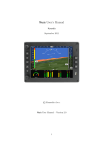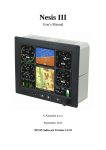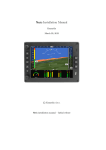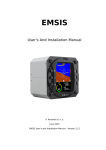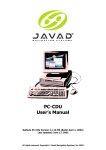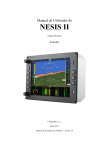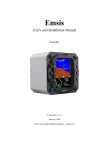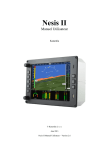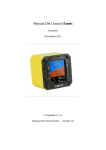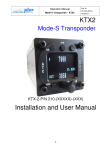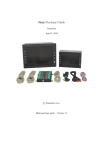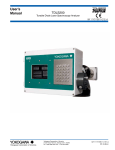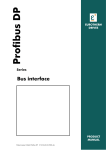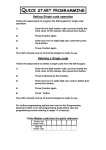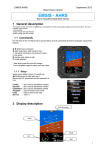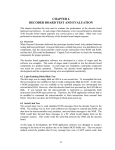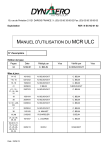Download User Manual for Nesis II
Transcript
Nesis II User's Manual Kanardia © Kanardia d. o. o. June 2013 Nesis II User's Manual – Version 2.6 Contact Information Publisher and producer: Kanardia d.o.o. Ulica heroja Rojška 70 SI-3000 Celje Slovenia Tel: +386 40 360 512 Email: [email protected] A lot of useful and recent information can be also found on the Internet. See http://www.kanardia.eu for more details. Copyright This document is published under the Creative Commons, Attribution-ShareAlike 3.0 Unported license. Full license is available on http://creativecommons.org/licenses/by-sa/3.0/legalcode web page and a bit more human readable summary is given on http://creativecommons.org/licenses/by-sa/3.0/. In short, the license gives you right to copy, reproduce and modify this document if: you cite Kanardia d.o.o. as the author of the original work and you distribute the resulting work only under the same or similar license to this one. Credits This document was written using Microsoft Office (Word) running on Microsoft Windows operating system. Most of the figures were drawn using Open Office Draw and Inkscape applications. Photos and scanned material was processed using Gimp. All document sources are freely available on request under the license mentioned above and can be obtained by e-mail. Please send requests to [email protected]. Revision History The following table shows the revision history of this document. Revision Date Description Document File 1.0 Sept 2011 Initial release NESISUserManual-200.pdf 2.0 June 2012 Added functions for new NESIS, added new update, ADS-B. NESISUserManual.pdf 2.6 June 2013 Added raster maps NesisManual.pdf Document can be downloaded from Kanardia web site http://www.kanardia.eu/downloads/nesis. 1. INTRODUCTION ...................................................................................................................................................5 1.1 General Information about NESIS ......................................................................................................................5 1.2 Principles of the Operation ................................................................................................................................6 1.2.1 Attitude, Heading and Velocities ...................................................................................................................... 6 1.2.2 Engine Sensors.................................................................................................................................................. 7 1.2.3 Sensor Calibration ............................................................................................................................................ 7 1.3 Maps, Flight and Navigation Information...........................................................................................................7 1.3.1 Free Maps ......................................................................................................................................................... 7 1.3.2 Licensed Raster Maps ....................................................................................................................................... 8 2. NESIS BASICS ........................................................................................................................................................9 2.1 Command Panel ................................................................................................................................................9 2.1.1 Multi-function buttons ................................................................................................................................... 10 2.2 Turning ON/OFF...............................................................................................................................................10 2.2.1 Start-up Procedure ......................................................................................................................................... 10 3. FIVE MAJOR SCREENS ..................................................................................................................................... 12 3.1 Classic Flight Information Screen .....................................................................................................................12 3.1.1 Menu .............................................................................................................................................................. 13 3.1.2 Moving Map Zoom Level ................................................................................................................................ 14 3.2 Navigation Screen ............................................................................................................................................14 3.2.1 Menu .............................................................................................................................................................. 15 3.2.2 Moving Map Zoom Level ................................................................................................................................ 15 3.3 Engine Monitoring Screen ...............................................................................................................................15 3.3.1 Menu .............................................................................................................................................................. 16 3.4 Modern Flight Information Screen ...................................................................................................................16 3.4.1 Menu .............................................................................................................................................................. 19 3.5 Settings Screen ................................................................................................................................................19 4 FLIGHT-TIME ACTIVITIES .............................................................................................................................. 20 4.1 Setting QNH .....................................................................................................................................................20 4.1.1 QFE Operation ................................................................................................................................................ 20 4.1.2 Initial QNH Setting .......................................................................................................................................... 20 4.2 List of Nearest Airports ....................................................................................................................................21 4.3 Selecting a Waypoint .......................................................................................................................................22 4.3.1 The Waypoint Selection Mode ....................................................................................................................... 22 4.3.2 Name Filter ..................................................................................................................................................... 23 4.3.3. Radius Filter ................................................................................................................................................... 23 4.3.4 Type Filter ....................................................................................................................................................... 23 4.3.5 New User Waypoint ........................................................................................................................................ 23 4.4 Route Selection ...............................................................................................................................................24 4.4.1 Activating a Route .......................................................................................................................................... 24 4.4.2 Route Manipulation ........................................................................................................................................ 25 4.5 Adjusting Fuel Level .........................................................................................................................................25 4.6 Setting Pitch Correction ...................................................................................................................................26 4.7 Pitch trim .........................................................................................................................................................26 4.8 Flap position ....................................................................................................................................................26 5 BROWSING THE MAP ....................................................................................................................................... 27 5.1 Moving the Map ..............................................................................................................................................27 5.2 Zooming the Map ............................................................................................................................................28 5.3 Waypoint .........................................................................................................................................................28 5.4 Route...............................................................................................................................................................28 5.5 Direct To ..........................................................................................................................................................28 5.6 Home...............................................................................................................................................................29 6 SETTINGS ............................................................................................................................................................. 30 6.1 Route Planner ..................................................................................................................................................31 6.1.1 Route List Commands ..................................................................................................................................... 32 6.1.2 Waypoint Editing Commands ......................................................................................................................... 32 6.2 Logbook...........................................................................................................................................................32 6.3 User Preferences .............................................................................................................................................34 6.3.1 User ................................................................................................................................................................ 34 6.3.2 Screen ............................................................................................................................................................. 34 6.3.3 System ............................................................................................................................................................ 35 6.4 Units ................................................................................................................................................................35 6.5 Compass Calibration ........................................................................................................................................35 6.6 Time ................................................................................................................................................................35 6.7 Software Update .............................................................................................................................................36 6.7.1 Downloading Updates .................................................................................................................................... 36 6.7.2 Performing Upgrade ....................................................................................................................................... 37 6.8 File Transfer Service ......................................................................................................................................37 6.9 Alarms .............................................................................................................................................................38 6.10 ADS-B/Flarm Settings ....................................................................................................................................39 6.11 User Waypoints .............................................................................................................................................39 6.12 Service Mode .................................................................................................................................................40 6.13 System Preferences .......................................................................................................................................40 6.13.1 Nesis ............................................................................................................................................................. 40 6.13.2 Glide ............................................................................................................................................................. 40 6.14 Level Adjust (AHRS) .......................................................................................................................................41 6.14.1 Yaw Misalignment ........................................................................................................................................ 41 6.14.2 Roll and Pitch Adjustment ............................................................................................................................ 41 6.15 Airplane & Engine ..........................................................................................................................................42 6.15.1 Engine Type .................................................................................................................................................. 42 6.15.2 DAQU Parameter Table ................................................................................................................................. 42 6.16 Tank Calibration .............................................................................................................................................43 6.17 Sensor Offset Correction................................................................................................................................43 6.18 Special Function ............................................................................................................................................44 6.19 Autopilot Tuning ............................................................................................................................................44 6.20 User Mode .....................................................................................................................................................44 7 INSTRUMENTS ................................................................................................................................................... 45 7.1 Airspeed Indicator ...........................................................................................................................................45 7.2 Attitude (AHRS) Indicator ................................................................................................................................46 7.3 Altitude Indicator ............................................................................................................................................47 7.4 Vertical Speed Indicator and Accelerometer ....................................................................................................47 7.5 Tachometer (RPM) and Manifold Pressure Indicator .......................................................................................47 7.6 Gyrocopter Rotor and Engine RPM Indicator ...................................................................................................48 7.7 Helicopter Rotor and Engine RPM Indicator .....................................................................................................49 7.8 Heading Indicator with Moving Map ...............................................................................................................49 7.9 Mini Engine Monitor........................................................................................................................................50 7.10 Fuel Computer Monitor .................................................................................................................................50 NESIS II User’s Manual 1. Introduction First of all, we would like to thank you for purchasing our product. NESIS is a complex instrument and we strongly recommend reading the manual before using NESIS. The introduction chapter contains some general information about the instrument and principles of the operation. Later chapters describe NESIS use and reveal the details. You may be also interested in reading: NESIS Purchase Guide, NESIS Installation Manual, DAQU Installation Manual, MAGU Manual, our web page www.kanardia.eu. 1.1 General Information about NESIS NESIS consists of electronic units which work closely together to bring flight, engine and fuel information onto graphical display. The system is presented on figure 1. The system consists of the following electronic components: Engine monitoring unit (DAQU) – used to connect the engine, fuel and electric sensors. Airu (AHRS and GPS unit) – further on referred as AHRS unit – as an inertial navigation unit aided by the GPS and pressure sensors, AHRS unit provides attitude, position and velocities. AHRS unit is hidden inside the NESIS Primary display. Mabu unit – is a hidden unit and serves as motherboard for the embedded computer, as a data logger and as a CAN bus interface. Mabu is an integral part of any NESIS display. NESIS Primary display – presents all relevant information that appears on the CAN bus in a pilot friendly form on a large LCD screen. Most of this manual describes how to access, read and interact with the NESIS display. Figure 1: Illustration of minimal NESIS configuration. The NESIS system can be easily extended into a much more complex form, shown on figure 2. We achieved this by introducing CAN bus for the communication between the units. The CAN bus does the magic of the all possible known and unknown future extensions. Imagine the CAN bus as a kind of computer network. Just like new computers can be easily connected to the network, we connect all new devices to CAN. This allows introduction of secondary NESIS display, autopilot, weather service, external 5 NESIS II User’s Manual warning panel lights, transponder... Although the secondary NESIS display does not have the AHRS unit inside, it is fully functional and behaves almost exactly like the primary NESIS display. The NESIS family of products and accessories keeps growing and growing. Please refer to the NESIS Purchase Guide for all available options. Figure 2: Illustration of extended NESIS configuration using CAN bus. 1.2 Principles of the Operation As it was indicated above, NESIS uses special units to provide the information. The flight information (attitude, position and velocities) is obtained by AHRS and MAGU (electronic compass) units, while all engine related information is obtained from DAQU unit. All these units are connected to the CAN bus. 1.2.1 Attitude, Heading and Velocities NESIS uses state of the art MEMS1 sensors to read various physical quantities. Since all sensors are solid state, NESIS has no moving parts. This means it has fewer problems with fatigue and ageing. The following MEMS sensors are used in the NESIS system: 1 2 The angular rate sensors, also known as gyros, are used in the attitude calculation. The angular rates are integrated in time in order to predict new attitude from the old one. We could say that they give short-time attitude prediction. They are also used in gravity vector calculation. The acceleration sensors are measuring apparent gravity vector. The true gravity vector is calculated assuming coordinated flight and readings from the other sensors (velocity and angular rate sensors). The ball slip indicator is directly obtained from the acceleration sensors. The absolute pressure sensor is used to calculate altitude and vertical velocity (vario). The differential pressure sensor provides indicated airspeed (IAS). When it is coupled with the outside air temperature sensor, it also calculates true air speed (TAS). The magnetic field sensors are used to measure the magnetic field vector. This vector is needed to determine the airplane magnetic and true heading. The later also needs magnetic declination, which is automatically calculated from the world magnetic model2 when airplane position is known. Note that the magnetic field sensor is optional and NESIS works well without it. MEMS - micro-electromechanical systems, a.k.a micro machines, a.k.a micro systems technology. The world magnetic model is maintained and updated by National Geophysics Data Center, http://www.ngdc.noaa.gov/geomag/ 6 NESIS II User’s Manual Assuming coordinated flight, we calculate the referencing attitude from the gravity vector and heading. These values are then compared with the short-term prediction of the attitude. Non-linear Kalman filters are used to combine the short-term prediction and referencing attitude solution into one most probable solution. This is what you see on the attitude indicator. In a very similar way, short-term inertial position prediction is compared with the GPS position. Again, Kalman filtering is used to obtain the final solution. 1.2.2 Engine Sensors Engine related sensors are connected to the engine monitoring unit (DAQU). DAQU unit is designed to be installed on the engine side of the firewall. This has two advantages: Since the unit is close to the engine, all cables are short and no extensions are needed. This means less weight and makes simpler installation. We only need one tiny hole through the firewall for the CAN bus cable. This cable transfers all the information and provides the power supply for DAQU unit. DAQU is designed to monitor engine sensors for various engines up to six cylinders (e.g. Rotax, Jabiru, Lycoming, etc.). When an engine is equipped with proper sensors, it can measure engine RPM, cylinder head temperature (CHT), exhaust gas temperature (EGT), oil pressure, oil temperature, fuel pressure, fuel flow, fuel level, manifold pressure, carburetor air temperature, voltage, battery current, alternator current, coolant temperature and more. In the case of gyrocopter or helicopter installation, it also reads the rotor RPM sensor. The results of all these measurements are then transmitted on the CAN bus, where all other units are able to read them. 1.2.3 Sensor Calibration Almost all MEMS sensors have one common problem – they are sensitive to the temperature change. This means that each unit must be calibrated individually. Each sensor of every unit is measured at different temperatures and compared with reference values. Results are optimized mathematically in order to minimize the sensor errors. Resulting calibration coefficients are written into flash memory of the microcontroller. This procedure can be done in our lab only, since some special tools and machinery are needed. The compass calibration, however, is an exception. Although the electronic compass (MAGU) is carefully calibrated in our lab, it needs to be recalibrated in your airplane. Practically every airplane has some magnetic material present in the compass surroundings. Such material locally disturbs Earth magnetic field and compass must take this disturbances into account. Refer to Magu Manual for detail explanation. 1.3 Maps, Flight and Navigation Information Maps, flight and navigation information is obtained from many different sources. Many of these sources are freely available on the Internet, while some raster maps information is licensed and provided from official sources. Wherever it is possible we cross-check the information and we try to make it current. However, this is not possible in all aspects and the quality of the information may vary from country to country. 1.3.1 Free Maps Free maps are provided by Kanardia as a combination of various free sources. They cover most of the populated world, but their precision is limited to the quality of the information that we relay on. This maps behave like a vector maps and can be rotated to the track up or heading up position. 7 NESIS II User’s Manual 1.3.2 Licensed Raster Maps DFS (Deutsche Flugsigrung) raster ICAO and Visual 500 maps are provided at the moment. These maps require a license, which must be purchased. Figure 3: Free vector map (left), licensed raster map (right). It is important to notice that we cannot guarantee that the information included with NESIS or otherwise provided by Kanardia is current and correct. It is the pilot responsibility to prepare himself for the flight and to collect all required information from reliable sources. It is strongly suggested that the pilot keeps valid printed navigation maps and other legally required material at disposal anytime during the flight. 8 NESIS II User’s Manual 2. NESIS Basics Basic chapter describes the organization of the NESIS instrument. It teaches you about the individual buttons and their meaning. After reading, you will be familiar with basic NESIS operations. Forthcoming sections reveal the details. 2.1 Command Panel The NESIS command panel is organized according to figure 4. It uses eight push buttons and two rotating and pushing knobs to manipulate the user interface. It has an USB port for software, map and data updates. Additionally it has an SD card slot for Flarm updates3. Figure 4: Organization of NESIS front panel. Here is a brief description of individual items: 1. The OK knob is mostly used to select things, confirm selection, change values, change zoom levels, etc. 2. The Cancel knob is used to change the NESIS screen, to reject selection, to cancel some decision or to change/escape to some other selection level. 3. The multi-function buttons Btn 1 ... Btn 8 have three modes: a. Direct short – with short push, the button directly accesses the function written on the upper side of the button. b. Direct long – with long push, the button directly accesses the function written on the bottom side of the button. c. Display mode - is active when at least one menu command is visible on the screen. 4. The USB port is used for software, map and data updates. 5. The SD card slot is used for Flarm software updates. 3 Flarm unit is needed. 9 NESIS II User’s Manual 2.1.1 Multi-function buttons QNH function – opens a dialogue for setting QNH. Pitch function – opens a dialogue for setting pitch. Near function – opens information about nearest airports. Wpt function – opens waypoint selection. Route function – opens route selection. Brws function – switches to browse mode. Log function – opens a logbook. Legend function – opens a legend. Hdg function – not implemented yet. Alt function – not implemented yet. Volume function – opens a dialogue for setting volume. Bright function – opens a dialogue for setting LCD brightness. User 1 function – not implemented yet. User 2 function – not implemented yet. Alarm function – opens a dialogue for setting alarms. Setup function – opens a settings screen. 2.2 Turning ON/OFF NESIS is connected to an avionics power bus, which has a mechanical switch between the bus and the battery, so it is automatically turned ON and therefore it does not have an ON/OFF button. 2.2.1 Start-up Procedure When NESIS is powered ON, the start-up procedure commences. The internal computer starts loading operating system and the NESIS main program. When the program is loaded, it continues loading various databases like airfields, navigation points, airspaces, maps etc. This procedure takes some time. Once the program is ready, it opens the start-up dialogue as shown on figure 5 (left). Figure 5: Initial agreement (left), pilot selection, QNH and fuel level settings (right). Pressing the OK knob accepts the agreement and advances to the next page. This page asks for the pilot name, QNH and fuel level as shown on figure 5 (right). Use the following commands to enter the required information: 10 NESIS II User’s Manual 1. Turn the OK knob to select the pilot4 and press it for confirmation. 2. This takes you to fuel level selection5. Turn the OK knob to set current fuel level and press it again. Act conservative and set slightly less fuel than you really have. 3. Use the OK knob to set QNH level. If correct QNH value is not known, it may be approximated by setting QFE altitude to the airfield elevation. Sometimes you want to go back and correct some selection: 1. Press the Cancel knob in order to switch from the control edit mode into the control selection mode. 2. Use the OK knob to select a pilot, fuel level or QNH control. 3. Pressing the OK knob puts the selected control into the edit mode. 4. Use the OK knob to pick a pilot, adjust QNH or fuel level and press it when done. Once the dialogue is closed, NESIS is ready to use. 4 5 You can't edit the list of pilots here. If you want to add a new pilot, remove or rename an existing one, refer to section 6.3. The fuel level option is shown only when no fuel level sensors are connected to the DAQU unit. 11 NESIS II User’s Manual 3. Five Major Screens This section describes five major screens used in NESIS. These screens are directly accessible by turning the Cancel knob. Figure 6 illustrates all screens available in NESIS: Figure 6: Five major screens in NESIS. 1. Classic Flight Information Screen, 2. Navigation Screen, 3. Engine Monitoring Screen, 4. Modern Flight Information Screen, 5. (User) Settings Screen. 3.1 Classic Flight Information Screen The first screen is the classic flight information screen. This screen shows flight information, which is the pilot’s primary concern. The most important instruments have classical look and follow the recommended IFR T layout (classic six-pack). Figure 7 shows an example of this screen. All round gauges are fully configurable and may show other information as well. Section 7 describes gauges more briefly. 1. The airspeed indicator displays IAS (indicated airspeed) and TAS (true airspeed). The indicator background can display white, green, yellow arc, VNE limit, recommended approach speed and other important speed limits. 2. The artificial horizon indicator (AHRS) provides current attitude and side-slip information. Roll and pitch angle can be read from the top and middle scale respectively. The ball indicates the sideslip. 3. The altitude indicator shows current baro-corrected altitude. It is available in feet or meters. When scale is given in feet, the third needle can be shown as well. It also displays current QNH reference pressure (a.k.a. baro-correction). 4. The variometer – vertical speed indicator. Variometer can be combined with g-meter (Acceleration) located below the center. 5. The fuel computer monitor provides the fuel and economy information. Level of the fuel in tank, current and average fuel consumption, approximate range and endurance. 12 NESIS II User’s Manual 6. The moving map is kind of HSI indicator, which provides basic navigation information. It is located below the artificial horizon. The moving map can be configured to follow aircraft true heading, tracking or magnetic heading. 7. The mini engine monitor organizes all most important engine parameters into one simple colored bar based map. Each bar corresponds to one parameter and the color of the bar to its current status. 8. The RPM indicator is combined with the manifold pressure gauge. This combination allows optimal setting of power level. Gyrocopters and helicopters have rotors and in this case engine RPM is usually combined with rotor RPM. Figure 7: Illustration of the classic flight information screen. 3.1.1 Menu Pressing the OK knob brings up possible commands for the classic flight information screen, see figure 8. The QNH command opens a dialogue where a QNH value is set. The Pitch command is used to adjust the pitch during the flight. The Airfield command allows you to select from airfields in your surroundings. Airfields are sorted according to their distance from current position. Selected airfield becomes a new waypoint and NESIS goes into the Direct to waypoint mode. See section 4.2 for more details. The Waypoint command opens a dialogue where a waypoint is selected from database. Waypoints can be filtered according to their type, distance from current position and name. On selection, NESIS goes into the Direct to mode. See section 4.3 for more details. The Route command opens two different dialogues. If no route is active, a route selection is offered. However, if a route is already active, a route leg or a route waypoint can be activated. See section 4.4. Figure 8: The menu options. 13 NESIS II User’s Manual 3.1.2 Moving Map Zoom Level NESIS keeps updating several different moving map zoom levels. These levels are seamlessly computed in the background and are immediately available. The only exception is the start-up, when NESIS needs some time to prepare the initial maps. Zoom levels are changed by turning the OK knob. 3.2 Navigation Screen The navigation screen is a large moving map combined with some additional information. Large HSI scale and vertical airspace situation are painted over the map. The top and bottom bars are used to display other significant information as it is depicted on figure 9. Figure 9: Illustration of the navigation screen. 1. A large horizontal situation circle over the map gives situational awareness. The HSI circle and map rotate according to current tracking, true heading or magnetic heading. Tracking/heading option is set in settings. 2. The current baro-corrected altitude is displayed, giving an idea what is the airplane vertical position regarding airspace zones. 3. Information about active route. The bottom bar includes estimated time of arrival to the last route waypoint, time from the last route waypoint, distance left and cross track error (perpendicular distance to the active leg). The route is also illustrated on the map. Black line represents the route and thicker cyan line is used for the remaining distance on the active leg. Rectangles next to waypoints show estimated time of arrival to that waypoint. 4. Current position of the airplane – the latitude and longitude coordinates6. 5. The bottom bar displays active waypoint, bearing, distance, tracking and time needed to reach the waypoint. 6 WGS84 system is used for the coordinates. The same system is used by GPS. 14 NESIS II User’s Manual 6. The mini engine monitor. 7. The top bar displays current wind speed and direction7, ground speed, name of the next waypoint, number of visible GPS satellites, local time (it can also show UTC) and flight time. 3.2.1 Menu Pressing the OK knob gives similar commands that were already described in the classic flight information screen section. New commands are Legend and Browse. The Legend command opens a legend dialogue shown on figure 10. The Browse command allows moving the map, creating routes and selecting Direct to points from the map. A detailed description of the browse mode is given in chapter 5. Figure 11: The menu options. Figure 10: Legend. 3.2.2 Moving Map Zoom Level NESIS keeps updating several different moving map zoom levels. These levels are seamlessly computed in the background and are immediately available. The only exception is the start-up, when NESIS needs some time to prepare the initial maps. Zoom levels are changed by turning the OK knob. 3.3 Engine Monitoring Screen The engine monitoring screen displays classic indicators of various engine and fuel related parameters. Some instruments and parameters are configurable and they may be adjusted to individual needs. Figure 12 illustrates an example of the screen. It is highly configurable and your screen (configuration for other aircraft) may look a bit different. 1. The fuel indicator combines the fuel related parameters like fuel flow, fuel level and manifold pressure. 2. Engine RPM combined with engine time is a reproduction of a classical instrument. 3. The indicator displays system voltage and current. Typically alternator current is shown. However, this depends on the current transducer installation. 4. Outside air temperature (OAT) is shown. 7 MAGU unit is required for the wind information. 15 NESIS II User’s Manual 5. Cylinder head temperature (CHT) indicator. Two CHTs are monitored; hence needles for hot (orange dot) and cold (blue dot) are displayed. When more than two cylinders are monitored, bars are used instead the needles. 6. Oil temperature indicator. 7. Flap position indicator. 8. Pitch trim indicator. 9. Oil and fuel pressures are combined into one indicator. Figure 12: An example of the engine monitoring screen. 3.3.1 Menu The engine monitoring screen has its own specific menu. New command is Fuel level. The Fuel Level command adjusts current fuel level. This option is available only when no fuel level sensors are connected to the DAQU unit and NESIS itself calculates fuel level. Please see note in section 7.10. Figure 13: The menu options. 3.4 Modern Flight Information Screen The modern flight information screen is composed of a background image and an overlay. The background image can show: synthetic vision, large artificial horizon, 16 NESIS II User’s Manual large moving map (similar to the navigation screen), check list, an image, that shows live video image from a compatible USB video, camera8, guidance screen for taking orthophoto pictures9. Figure 14: Dialogue for changing views. The overlay shows various flight parameters in form of bars and scales. The upper part shows flight information, while the lower part is reserved for the engine parameters. Figure 15: Different views of the modern flight information screen: Synthetic Vision (1), Moving Map (2), Check list (3) and Video from camera (4). 8 9 One useful example may be glider towing – a back facing small camera may replace a mirror and provide unobscured video image of the glider. Geoniss orthophoto device must be connected to the CAN bus for the orthophoto mode to be operational. 17 NESIS II User’s Manual Figure 16: Modern look of the flight information screen. Artificial horizon is taken for the background. The overlay consists of the following items: 1. The Compass scale moves according to current airplane heading or tracking. This depends of the settings. 2. The scale displays the heading bug marker (yellow triangle), which gives you direction to the selected waypoint. 3. The Heading/Tracking displays true heading, tracking or magnetic heading. 4. The Altitude scale displays altitude. When the altitude indicator approaches to the top of the scale, it is rescaled automatically. 5. The VSI (vario) scale. 6. Acceleration due to gravity. 7. The moving altitude label. The altitude label moves, while the scale background is kept constant. This way we try to mimic the behavior of classic instruments, where the position of the needle gives the information without the need to actually read the label. 8. The vario label displays current value of the vertical speed. 9. Current QNH setting (baro-correction) is displayed below the altitude and vario scale. 10. The electric instruments section (voltage and current). 11. Wind curse and speed. 12. The pressure section (oil and fuel pressures). 13. The inclinometer (slip-skid) indicator. 14. The temperature section (EGTs, CHTs, carburetor, oil and coolant). 15. Information about active route. The information displays the name of the currently active route, bearing, distance covered and flight time. 16. The RPM indicator with the RPM scale. 17. The TAS label is located below the airspeed scale. 18 NESIS II User’s Manual 18. The airspeed information. 19. The airspeed scale with the colored sections and limiting values. 20. The attitude indicator (AHRS) together with the roll and pitch scale. 3.4.1 Menu The menu has the same commands as the menu of the classic flight information screen. There is an additional View command, used to change the view, see figure 17. The View command opens a dialogue shown on figure 14 where the background image can be selected. Figure 17: The menu options. 3.5 Settings Screen Individual icons on the screen lead to various configuration dialogues. Due to the complexity, the Settings screen has its own chapter 6. Figure 18 illustrates the screen. Figure 18: User settings (left) and Service settings (right). 19 NESIS II User’s Manual 4 Flight-Time Activities This chapter describes procedures that are mainly used during flight. The major flight-time activities are: Setting reference QNH pressure. Selecting an airport from the nearest airports list. Selecting a waypoint. Selecting an existing route or a route leg. Adjusting fuel level. Setting pitch correction. Setting trim/flap position. 4.1 Setting QNH The QNH setting is accessible from the classic flight information, engine monitoring screen and modern flight information screen. Press the OK knob to display the menu and press the QNH command. QNH setting can be also accessed via QNH multi-function button. A dialogue pops-up illustrated on figure 19. Figure 19: Setting the QNH. Turn the OK knob to set correct QNH reference pressure and press it to accept the selection. This also closes the dialogue. Optionally, you can simply wait and NESIS will accept given value after a few seconds. Press the Cancel knob to reject changes. Dialogue closes. 4.1.1 QFE Operation When you operate your airplane locally, say around domestic airfield, you may set the QFE altitude rather than QNH. In order to set your altimeter to the zero altitude (the QFE altitude), turn the OK knob until the bottom number is close to zero10, but be careful. You can do this only while you are sitting on the ground. Otherwise the QFE setting will be wrong. 4.1.2 Initial QNH Setting When QNH is not known and you are sitting on an airfield with a known altitude, you can approximate QNH value by setting the QFE altitude to the known airfield altitude. This gives a pretty good QNH approximation. 10 Normally, you can't get exact zero because baro-correcting pressure change is made in discrete steps. One hPa at the sea level corresponds to approximately 8 meters of altitude. 20 NESIS II User’s Manual 4.2 List of Nearest Airports The list of nearest airports is available from the classic flight information screen, navigation screen and modern flight information screen. It is considered to be a kind of a distress feature. In order to access the list, press the OK knob to display the menu and select the Airfield command. A dialogue shown on figure 20 appears. List is also available by pressing Near multi-function button. Figure 20: Selecting from the list of nearest Airfields. Airfields are sorted according to the distance from the airplane position at the time when the button was pressed. Distance and bearing are shown for each airfield. Colored arrows indicate the relative direction to the airfield according to the direction of the aircraft at the time when the list was created. Arrow colors indicate whether an airfield can be reached in the glide mode11: Red arrow indicates that airfield can't be safely reached in the glide mode. Yellow arrow indicates that airfield might be reached in the glide mode, however below the safety altitude. Green arrow indicates that airfield should be reached in the glide mode at or above the safety altitude. Minimal safety altitude and glide ratio are configured in settings. Refer to section 6.13 for more details. Important note: the arrow colors calculation does not take terrain into account. So, it is possible that an airfield is marked as green, but it is not reachable due to the high terrain between the airplane and the airfield. With the list is active, the following commands are available: Turn the OK knob to select the desired airfield and press it to accept the selection. Select the ICAO command to show only ICAO airfields (default option). Select the All command to include airfields and landing fields which are not in ICAO. Select the Close command to close the dialogue. The selected airfield becomes new waypoint and NESIS goes into the Direct to mode. 11 Glide mode means that engine is not running and that the airplane is flying at the speed of the best glide. 21 NESIS II User’s Manual 4.3 Selecting a Waypoint A waypoint selection is a bit more complex process then selecting one of the nearest airports. NESIS maintains separate lists of airfields, navigation aids12, VFR reporting points13 and user points. As in the nearest airfield case, all points are sorted according to the distance from the airplane position at the time when the list was created. Since there are many points available for selection, filters need to be applied in order to hide some of the points. There are three types of filters and all of them are acting simultaneously: Range filter is used to limit the search to some reasonable distance. If you do not see your point on the list, consider to increase the radius limit. NESIS remembers last radius used and will reuse the same radius on the next run. Type filter is used to include or exclude individual lists: airfields, navigation aids, VFR reporting points and user specific points. Name filter is used to filter points according to their name. Only names which match given pattern are listed. In the case of airfields, NESIS searches for the name or ICAO label. To open a dialogue, from modern flight information screen, classic flight information screen or navigation screen press the OK knob and select the Waypoint command (or press Wpt multi-function button). Figure 21: The waypoint selection dialogue. 4.3.1 The Waypoint Selection Mode The dialogue always starts in the waypoint selection mode with radius filter and type filter set to previously used values. The previous setting of the name filter is reset, however. 12 13 Turning the OK knob changes current selection. Pressing the OK knob accepts the selection and sets it as a new waypoint in the direct to mode. The Name command activates the name filter editing. The Radius command activates the radius control. The Type command activates the type selection. The New command opens a dialogue where you can add a new waypoint. The Close command closes the dialogue, rejecting any selection. By the navigation aid we mean VORs, NDBs, ILSes, TACANs and other similar radio navigation aids, which locations are often used in VFR flight for the navigation. In Europe, VFR reporting points are more and more used in VFR flights to define the flying routes and entry/exit points between airspace zones. 22 NESIS II User’s Manual 4.3.2 Name Filter The name filter allows you to enter a few letters. As letters are entered, the list displays only those waypoints, which name matches letters in the filter. Figure 21 illustrates the situation where the letter L is about to be entered in the name filter. Note that airfields are matched against ICAO labels or airfield names at the same time. Once the name filter control is in the text edit mode, you have the following options: Turn the OK knob until desired letter is displayed. Press the OK knob to enter the displayed letter into the name filter field. The list of waypoints changes accordingly. Press the Cancel knob to remove the last letter in the edit box. Press the OK knob to stop editing. Repeat the first two steps in order to enter more than one letter. 4.3.3. Radius Filter When the radius filter is active, you have the following options: Use the OK knob to change the waypoint search radius. As soon as radius is changed, the number of items found changes. Select the Accept command to accept the new radius and switch back into the waypoint selection mode. Press the Cancel knob to keep previous radius and switch back into the waypoint selection mode. Large radius makes NESIS a bit less responsive since it needs to scan among large number of waypoints. Please note that the list is able to display only 99 closest waypoints. If your waypoint is not listed, you should apply stricter filter, say the name filter. 4.3.4 Type Filter The type filter toggles the lists used in waypoint selection. Here you can: Use the OK knob to select which waypoint list type to include or exclude. Press the OK knob to toggle current selection. Select the Accept command to switch back into the waypoint selection mode. 4.3.5 New User Waypoint The New command opens a dialogue where a user waypoint is created. A new waypoint requires coordinates (latitude and longitude) and a name. Initially, current airplane position is shown. Degrees, minutes and seconds are used to describe a coordinate. 1. Turn the OK knob to select the coordinate field you want to change. 2. Press the OK knob to go into edit mode and turn it to change it. Once correct value is shown in the field, press the OK knob again. This accepts the entry and advances to the next field. 23 NESIS II User’s Manual Figure 22: An example of the user waypoint dialogue. As you modify the coordinates, a small map14 is shown on the right. This map is centered at the coordinate position. The map can be zoomed by selecting the Zoom + and Zoom - commands. The Back command sets the coordinate fields back to the initial point. Once the coordinate is known, select Save command to save this point into the NESIS flash drive. Select Close in order to close the dialogue without saving the new user waypoint. User waypoint can be created, edited and deleted in settings. Please refer to section 6.11. 4.4 Route Selection This section describes how to activate and manipulate a route. It is assumed that the route was already created. The route planning is described in section 6.1 and in section 5.4. The route functions are accessed via the Route command or Route multi-function button. Depending on the current situation, the button opens two different dialogues. If there is no active route, NESIS opens the route selection dialogue. However, if some route is already active, NESIS opens the route manipulation dialogue. Both options are described next. 4.4.1 Activating a Route With no active route, the Route command opens a list shown on figure 23. This list displays all existing routes. Routes are sorted alphabetically. Turn the OK knob to select a route and press it or select Activate command to activate it. Select the Cancel command to close the route selection list. Figure 23: Selection of a Route. When a route is activated, any previous active waypoint is deactivated. According to the airplane position, NESIS first tries to activate the starting waypoint of the route. Direct to is used in this case. However, when NESIS determines that airplane position fits into one of the route legs, the leg mode is activated showing the remaining part of the leg to fly. 14 At the moment, raster maps are not supported in the user waypoint dialogue. 24 NESIS II User’s Manual The above assumption may not be suitable for every situation and we need a mechanism to select either a different route leg or a different route waypoint. 4.4.2 Route Manipulation When a route is already active, the Route command brings up the route manipulation dialogue shown on figure 24. This dialogue allows change of currently active route waypoint. It also allows deactivating the route completely. Figure 24: Selection of a leg or a waypoint in an existing route. Use the OK knob to select a route waypoint. The Select Leg command selects a leg on the route that leads to the selected waypoint. NESIS switches to the route mode guiding you to follow the selected leg. The Direct To command guides you to the selected waypoint in the Direct to mode. Press the Deactivate command to deactivate the route. 4.5 Adjusting Fuel Level This option is available only when no fuel level sensors are connected to DAQU unit and NESIS calculates remaining fuel from the fuel flow information. Fuel level is first adjusted during the NESIS start-up procedure. However, if you need to modify it during the flight, switch to the engine monitoring screen, press the OK knob and select the Fuel Level command. A dialogue similar to figure 25 appears. Turn the OK knob to adjust the fuel level. Note that the fuel level changes in steps. Act conservative and set slightly less fuel than you really have. Confirm the selection by pressing the OK knob. Reject and close the dialogue by pressing the Cancel knob. Figure 25: Setting a fuel level. 25 NESIS II User’s Manual 4.6 Setting Pitch Correction Switch to the classic flight information screen, press the OK knob and select the Pitch command. You can also directly access the dialogue by pushing Pitch multi-function button. A dialogue similar to figure 26 appears. Turn the OK knob to adjust the correct value for pitch correction. Confirm the selection by pressing the OK knob. Reject and close the dialogue by pressing the Cancel knob. Figure 26: Setting pitch correction. 4.7 Pitch trim Please refer to DAQU Installation Manual for connection and settings. Once you have configured your Pitch trim setting, by moving Pitch trim, the window illustrated on figure 27 opens. Figure 27: Pitch trim display window. 4.8 Flap position Please refer to DAQU Installation Manual for connection and settings. Once you have configured your Flap position setting, by moving Flap position, the window illustrated on figure 28 opens. Figure 28: Flap position display window. 26 NESIS II User’s Manual 5 Browsing the Map The navigation screen has a special menu command called Browse, which changes the navigation map mode into the browse mode15. Brws multi-function button gives you direct access to the browse mode. The browse mode allows you to: Move the map to any position you want. Do the graphical route planning. Set the direct to waypoint to a point selected on the map. Activate newly planned route. Figure 29: Browsing the map. Radial directs to north. On the left side, browse specific menu is shown. 5.1 Moving the Map At the first use after NESIS start-up, the map is centered at the airplane position. Later on the position of the previous browsing is preserved. During browsing, the map orientation is always North up. A small circle called cursor is used to move the map around and to refer to some specific points on the map. The cursor is always located on a radial line, which starts at the map center. A point on the map is selected in two steps. In the first step radial line is adjusted so that it covers the point. In the second step, the cursor is moved along the radial line over the point. Radial and cursor are working in a polar coordinate system. Using the radial and the cursor, the map is moved by repeating three simple steps. These steps may be repeated as long as it is necessary: 1. Use the OK knob to adjust the radial angle. The radial line rotates in large steps. Press the OK knob when the line is close to the point where you want to move. It switches to the fine radial selection step. 2. Now use the OK knob to do the fine radial selection and press it to switch to the cursor move step. 3. Use the OK knob to slide the cursor on the radial line. Slide the cursor to the point where you want to center the map and press it. This centers the map and switches back to the large step radial selection. If you want to exit browse mode, you have to press the Cancel knob. 15 At the moment, raster maps are not supported in browse mode. 27 NESIS II User’s Manual 5.2 Zooming the Map In order to change the zoom level of the map, select the Zoom command and turn the OK knob. Once correct zoom level is reached, select the Cursor command to switch back to the cursor-radial mode. 5.3 Waypoint The map can be moved to some known waypoint directly using the Waypoint command. It opens a waypoint dialogue. Select a waypoint from the list and press the OK knob. The map will be centered at the selected waypoint automatically. 5.4 Route The Route command is mostly used to create a new route from a series of cursor positions or waypoint selections. This command opens a list of option which are briefly described below: Route|New starts a new route and clears any existing route points which were entered so far. Route|Add adds the cursor position as a new route waypoint. If there is a known navigation point close to the cursor position, this point is used. Otherwise a temporary waypoint with cursor coordinates is used. Route|Save saves the route into NESIS flash drive. It does not activate the route, however. Route|Activate activates the route. It exits the browse mode and switches back to the flight mode with the newly created route being active. Note however, that the route was not saved automatically. Once the NESIS is turned OFF, restarted or a new route is activated, the route is lost. Therefore you should consider saving the route before activating it. Route|Edit activates classic route manipulation window. This window is described in section 6.1. Route|Del. Wpt. removes the last waypoint form the route. When route is empty, it does nothing. In order to create a route using a series of cursor positions, follow the next procedure: 1. Move the cursor to some point, where you want to start a route. 2. Select the Route|New command. This sets the cursor position as the first route point. At the same time, map is centered at the route starting point and the top bar on the map becomes visible. 3. Move the cursor to next route waypoint either by using radial-cursor approach or by selecting a waypoint from the dialogue. 4. Press the Route|Add command to add the cursor to the route. Repeat the last two steps until the route is complete. 5. Finish the route by saving it to the NESIS flash drive. Press the Route|Save command. 6. If you want to activate the route, choose the Route|Activate command. This exits the browse mode, switches to the flight mode and activates the route immediately. 5.5 Direct To The Direct To command sets cursor location as a new active waypoint. The command exits the browse mode and shows the normal flight mode map. Newly created waypoint becomes active in the Direct to mode. 28 NESIS II User’s Manual 5.6 Home The Home command is used to move the map back to the current aircraft position. 29 NESIS II User’s Manual 6 Settings The Settings screen allows choosing from several different icons. It is accessed by selecting Setup multifunction button. Figure 30 (left) illustrates the screen. The settings icons are arranged into two groups. The first group consists of icons which are accessible to the user (left), while the second group consists of icons which are accessible to the service personnel only (right). Figure 30: User settings (left) and Service settings (right). The following options are available in the User settings. Each option is described later in individualy. The Route Planning icon is used to create, delete and edit the routes. The Logbook icon is used to view, copy and delete the flight logs. The User Preferences icon is used to change some parameters which define NESIS behavior. The Units icon is used to change the instrument units. The Compass Calibration icon is used to calibrate compass or to adjust the compass heading correction. The Date & time icon is used to set the NESIS time zone. The Software Updates icon allows updating the NESIS software and firmware of units connected to the CAN bus. The File Transfer Service icon is used to copy map updates, check lists, translations and other data. The Alarms icon is used to set individual alarms. The ADS-B/Flarm Settings icon is used to set the ADS-B and Flarm limits16. The User Waypoints icon allows adding, editing, deleting and transferring17 user specific waypoints. The Service Mode icon is a gateway to the Service settings. Some user options are not shown on secondary NESIS display, some options require password entry before proceeding and some options are available only when correct hardware is detected. The factory default password is 314, first three most significant digits of number π, as seen on figure 31 The password was introduced in order to prevent unwanted accidental alterations of important settings. 16 17 Functional only when ADS-B/Flarm unit(s) are connected to NESIS. Functional only when secondary NESIS display is connected to the CAN bus. 30 NESIS II User’s Manual Figure 31: Password is required in order to open certain options. The Service settings require special password, which is specific for each NESIS. The following options are available. These options are executed rarely and require extra care. The System Preferences icon is used to set instrument screen configuration and flight parameters. The Level Adjust (AHRS) icon is used to adjust the installation specific roll, pitch and yaw correction angles of the AHRS unit. The Airplane Engine icon configures the engine related settings and sensors connected to the engine monitoring unit (DAQU). The Tank Calibration icon starts setup procedure for the fuel level measuring hardware and runs procedures required for the fuel tank shape calibration. The Sensor Offset Correction allows zero adjustments of several sensors and engine time. The Special Functions. The Autopilot Tuning. The User Mode icon allows you to switch back to the User settings. 6.1 Route Planner The Route Planner is used to manipulate routes. The routes may be created, edited, deleted or reversed. Typically, routes are created on ground as a part of the flight planning process. You can also use the browse mode of the navigation screen to create the routes. See section 5.4. Figure 32: An example of the route planning screen. Figure 32 shows the Route Planner dialogue. It has three logical parts: 1. The Cruising speed indicates your cruising speed. You can change it in the User preferences dialogue. 2. The Routes list displays all existing routes. Routes can be created, edited, deleted or reversed. 3. The Waypoints list displays all waypoints in the selected route. When the waypoint list is active, waypoints can be inserted, deleted and reversed. 31 NESIS II User’s Manual 6.1.1 Route List Commands The following commands are available with the route list control: The New command creates an empty route. A dialogue shown on figure 33 appears and asks for the route name. Keep the input empty and NESIS will generate a route name for you. The name will be a combination of the first and last waypoint on the route. Figure 33: Entering a name for the new route. The Edit command activates the waypoint list control where waypoints can be inserted or removed. The Delete command permanently removes selected route. The deletion must be confirmed. The Reverse command reverses the waypoints in the route. When a route is planned in one direction, reversing it gives a route in the opposite direction. The Close command closes the route planning. Changes are saved automatically. 6.1.2 Waypoint Editing Commands When the waypoint editing control is active, the following commands can be used: The Insert command inserts a new waypoint before the selection. The waypoint is obtained from a dialogue, which was already described in section 4.3. The Delete command removes currently selected waypoint. The Rename command allows you to specify a new name for the route. An empty name results in a name which is composed of the first and the last route waypoint. The Reverse command reverses the waypoints in the route. When you plan a route into one direction, reversing it gives you a route in the opposite direction. The Save command saves changes. 6.2 Logbook Logbook serves as a pilot log. It records flights and displays them on the list. An example of such record is given on figure 34. Logbook can also be directly accessed by pushing the Log multi-function button. The following commands are available in menu: The Copy log command copies complete logbook to the connected USB drive. The Copy flight command copies selected flight to the connected USB drive. The Delete command deletes selected flight or the whole logbook. The deletion must be confirmed. To cancel the decision, press the Cancel knob. Each log entry reveals several details of a selected flight. These entries in the log have the following columns: 32 NESIS II User’s Manual Date when the flight was taken. Take off time. Landing time. When you fly traffic patterns, NESIS will try to merge the patterns into one record. In this case the take off time will be the time of the first take off and the landing time will be the time of the last landing. Time is the total flight time. Pilot of the airplane. Figure 34: The logbook displays list of most recent flights. Turn the OK knob to change the selected flight. Changing the flight reveals further details about the flight: The engine ON/OFF control tells when the engine was started and stopped for the selected flight. In case of motor gliders, it displays first engine start and the last engine stop. The cycles/time control holds number of engine cycles during the flight. Typically, just one cycle is shown, however motor gliders (powered gliders) may have more. The time is the total engine time during the flight. The distance control gives information about the distance traveled during the flight. This is not a distance on a route or between two most distant points in the flight, but simply a distance like it would be measured in a car18. The speed avg/max control shows the average and the maximal true airspeed on your flight. The total and specific fuel consumption is given in the fuel tot/spec control. Maximal altitude reached during the flight is also recorded. It is presented in the Alt max box. NESIS uses quite sophisticated algorithms to record true flights. It distinguishes between a flight time and a block on/block off time. Furthermore, if you have a motor glider, it correctly detects that engine was turned OFF and that you are in the gliding mode. NESIS considers that a flight has started when airspeed is larger than 12 m/s (43.2 km/h) and that a flight has finished when airspeed drops below 12 m/s. Engine is monitored in parallel. An engine start is detected when engine exceeds 500 RPM and engine stop is recorded when RPM drop below that limit. Special algorithms are used to prevent false flight or engine recordings due to false engine starts or wind bursts. Important: In order to provide all this information, NESIS needs to monitor engine RPM beyond the engine stop. The current flight will be closed about 10 seconds after the engine has been stopped. This means that engine must be stopped before NESIS is turned OFF in order to close the log properly. 18 Mathematically speaking, if v(t) represents TAS and t represents time, then the distance D is calculated as D = v(t)dt. 33 NESIS II User’s Manual Stopping the engine and turning NESIS OFF later is in a dispute with common behavior of most pilots. They usually turn OFF all the avionics and stop the engine last to prevent unnecessary discharge of the battery. NESIS uses only 0.8 A at 12 V (about 10 W)19 and has almost no impact on battery when running for a few minutes. 6.3 User Preferences This dialogue allows customizing user preferences. There are several logically grouped sections. An example is given on figure 35. Figure 35: The user settings dialogue. Use the Close command to save the changes and to close the dialogue. In most cases, this restarts NESIS. 6.3.1 User The User section deals with pilot names, language and cruising speed. Select the active pilot from the list of pilots. The pilot list also allows entering a new pilot, editing a name of an existing pilot or deleting a pilot from the list using New, Edit and Delete commands, respectively. The language selection option affects the language of the NESIS user interface. It also affects the language of the voice messages. When translation is not available, English is used instead. The Cruising speed control is used to enter typical ground speed during cross-country flights. This speed is used to calculate time estimates. NESIS remembers last used cruising speed. 6.3.2 Screen Screen section defines the way map is presented. All screens with map on it are affected: classic information screen, navigation screen and modern flight information screen. Three options are available here: 19 Heading up shows map oriented according to the true heading. This option is meaningful only if magnetic compass (MAGU) is present on the CAN bus. Tracking up shows map aligned to the GPS tracking angle. One NESIS display with DAQU and MAGU is assumed. Two NESIS displays with DAQU and MAGU are consuming about 1.5 A at 12 V. 34 NESIS II User’s Manual Magnetic up shows map aligned to the magnetic heading. Note that compass unit (MAGU) is required for this operation. Start screen allows you to choose the NESIS start-up screen. 6.3.3 System The System section allows setting LCD brightness and audio volume level. As you change the values, screen brightness and audio volume react accordingly. 6.4 Units NESIS uses several units for different physical quantities like distance, velocity, mass, volume, etc. They affect the instruments and texts. Table 1 shows available units. The quantities are grouped according to their function and not to their physical meaning. Physical quantity Available units Altitude (length) meter, feet Airspace altitude (length) feet Vario (vertical velocity) m/s, ft/min, m/min Speed (velocity) km/h, kts, mph Wind speed (velocity) km/h, m/s, kts Distance (length) km, SM, NM QNH (pressure) hPa, inHg Pressure (used in engine) bar, psi Temperature C, F Mass kg, libs Fuel (volume) l, gal Fuel flow l/h, gal/h Table 1: Available units for the individual physical quantity. Figure 36 shows a dialogue for changing units in NESIS. When the units are configured, use the Save command to save the selection to NESIS. Close command will exit the dialogue. If units were changed, NESIS will restart. 6.5 Compass Calibration Due to complexity of electronic compass (MAGU) installation and calibration, all details are explained in Magu Manual. 6.6 Time Dialogue is used to set the time zone for local time. A time difference between local time and the UTC time must be set. Some countries (India and Iran, for example) do not round the time difference to whole hour, but to 30 minutes. Some areas in Australia even use 15 minutes local time intervals. 35 NESIS II User’s Manual Figure 36: Units selection dialogue. To edit the NESIS time zone, follow next procedure: Turn the OK knob to select control and press it to start editing. Use the OK knob to set the hour/minute difference and press it to accept new value. Press the Cancel knob to restore previous value. Select the Close command to close the dialogue. Changes are saved and NESIS restarts. Figure 37: Time zone setting. 6.7 Software Update The NESIS software is under constant development and if you want to keep your NESIS up to date, you should update your NESIS regularly. This section describes actions required to update the software. 6.7.1 Downloading Updates The software updates can be found in the update page of our web site; http://www.kanardia.eu/downloads/nesis. The update for NESIS is performed in several steps: downloading update, copying update file into an USB stick, transferring file from USB stick into NESIS, updating firmware. 36 NESIS II User’s Manual Click on the update file and save it to a hard drive of your PC computer. The name of the file should be Nesis-2.x.x.kus. If you have two or more NESIS units on board your aircraft, you need to update each one separately. 6.7.2 Performing Upgrade The update file is simply a kus file. This file must be copied into the USB stick, more precisely into the base (root) folder of the stick. Once file was copied, please make sure that the USB stick is safely removed from PC. To upgrade correctly, follow these steps: 1. Insert USB stick with program upgrade into NESIS USB port. 2. Select the Software Update icon from the settings screen and restart NESIS. Wait until a dialogue similar to figure 38 opens. Use the OK knob to select Upgrade command and press it. Note: If no dialogue for NESIS restart is shown, the version of the program on your NESIS is older than required. Please refer to the NESIS I User’s Manual for further instruction. Figure 38: Boot options dialogue. 3. Dialogue illustrated on figure 39 opens with kus file on it. Select the upgrade file (kus file) to start upgrading NESIS. Figure 39: Select file dialogue from the USB stick. 4. Once finished, NESIS programed up to date will start. If not and the upgrade is not finished or nothing changes for more than 5 minutes, turn NESIS OFF. Please return to step 2. 5. At first start up, NESIS will detect the version of firmware on all connected devices. If any version is out of date, NESIS will automatically program firmware to the newest version. Note that NESIS will program a connected device (MAGU, DAQU, Geoniss, etc.) when it will be introduced (connected) to NESIS for the first time. 6.8 File Transfer Service Dialogue in figure 40 is used to copy new files into NESIS. You can copy updates for maps, check lists, translations and other data. 37 NESIS II User’s Manual Figure 40: File transfer service dialogue. When USB key with updates is inserted, new files are listed in the Files to copy section. Simply select the file you want to copy and Copy command to proceed. First files are verified and then copied. When Close is selected and file(s) were copied, NESIS will restart. Note that when verification of any file fails, no file will be copied into NESIS. The Edit Maps opens a new window with raster maps info illustrated on figure 41. Each map entry reveals several details in the following columns: Name of the raster map. Authorization of the map. License of the map – if Lic is colored green, map has a valid license, if not, Lic is colored red. The date when raster map was created. The size of the map. The name of the file containing raster map. The Delete command allows deleting selected raster map. Close the window and return to the File Transfer Service with Cancel knob. Figure 41: The Edit Maps window. 6.9 Alarms This dialogue is used to configure individual alarms. Each alarm can be set to one of the options: Disable is used to disable alarm completely. This is useful in case of a sensor failure. A faulty sensor keeps signaling false alarms and here you disable it until sensor is replaced. 38 NESIS II User’s Manual Text is used to display alarm without any sound. Sound is used to play a beep sound. Voice is used to play a voice describing the alarm. Alarm text output and human voice depend on the language settings. When selected language is not available, English is used. Figure 42 shows the dialogue. Figure 42: Alarms configuration dialogue. 6.10 ADS-B/Flarm Settings Automatic Dependent Surveillance Broadcast is communications – navigation – surveillance air traffic technology. It uses Global Navigation Satellite System (GNSS) technology and a relatively simple broadcast communications link as its fundamental components. ADS-B allows pilots and air traffic controllers to “see” and control aircraft with transmitting aircraft’s position and track, which tells where the aircraft will be over time if it continues flying straight. Flarm, active and cooperative traffic system, was also designed as collision-warning system. It is aware of aircraft established in a turn (especially thermalling) and it transmits the expected position of the aircraft over the next 20 seconds. With ADS-B and Flarm technologies, your NESIS unit shows aircrafts in surroundings on navigation screen. Visibility of aircrafts can be manually set by reducing or decreasing Relative vertical limit and Horizontal limit in a dialogue seen on figure 43. Figure 43: ADSB/Flarm settings dialogue. 6.11 User Waypoints NESIS allows storing user specific waypoints. These waypoints may be entered during the flight, see section 4.3.5 and can be edited using a dialogue illustrated on figure 44. Use New command to enter new user waypoint in the system. The Edit command will modify selected user waypoint. Use Delete command to remove the selected user waypoint. Use Transfer command to transfer user waypoint to secondary NESIS. Use Close to exit. 39 NESIS II User’s Manual Figure 44: Example of the user waypoints editing dialogue. 6.12 Service Mode Is a gateway to the Service settings. A special password is required to open the screen and is shipped together with NESIS. 6.13 System Preferences The system preferences are separated into two sections. The first one covers the look of the NESIS screen, while the second deals with the aircraft gliding performance. Figure 45: An example of the system preferences dialogue. 6.13.1 Nesis The NESIS subsection mostly deals with the look of the NESIS screen, which instrument layout shall be shown, type of the modern screen and availability of the demonstration mode. Normally, the instruments selection should never be changed, since NESIS comes with the selection tuned for your aircraft. Do not change this unless we advise you to do so. Demo option is normally not selected. However, when set to Yes it allows NESIS to go into the demo mode. This also enables a demo icon on the User settings screen. Note that demo mode requires specially prepared demo files on an USB key. Without such files, demo mode is not operational. 6.13.2 Glide The glide settings are only meaningful for airplanes. Helicopters and gyrocopters do not benefit much from them20. The glide parameters are the airplane glide ratio a.k.a. finesse and the altitude reserve. These 20 Set finesse not more than 1 for gyrocopter or helicopter case. 40 NESIS II User’s Manual settings are used in the Airfield dialogue, where a list of nearest airfields is given. See section 4.2. Please, set the finesse conservatively (smaller numbers are conservative), use one or two values less than given by aircraft producer. Also, set at least 200 meters for the altitude reserve. 6.14 Level Adjust (AHRS) During the assembly of the AHRS unit into the primary NESIS display and during the installation of the NESIS display into the instrument panel, a small misalignment may appear. This means that internal axes of the AHRS unit are not parallel to the airplane axes – the AHRS unit is slightly rotated. Such misalignment can be perfectly adjusted without loss of precision using the procedure described next. Before the automatic alignment is made, the yaw misalignment shall be determined. Please note that you can't adjust the attitude when the airplane is flying or engine is running. 6.14.1 Yaw Misalignment If the instrument panel is perfectly flat and perpendicular to the airplane x-axis (longitudinal axis), then there is no yaw misalignment and the correction angle is zero. This perfect situation is illustrated on figure 46 (left). Some instrument panels or NESIS installations are skewed regarding the airplane x-axis (longitudinal axis). In this case you need to measure the misalignment angle ψ and enter it into NESIS. NESIS accepts corrections up to 10°. Figure 46 defines positive and negative ψ angle. Once ψ is measured, enter it into the Yaw control. Yaw correction affects the roll and pitch correction as well. Hence it is important to be set before roll and pitch corrections are made. Figure 46: Illustration of possible yaw misalignment of NESIS – top view; perfect position (left), positive yaw misalignment error (middle), negative yaw misalignment error (right). 6.14.2 Roll and Pitch Adjustment Once yaw correction is known (in most cases it is zero), roll and pitch can be automatically corrected. Make sure that airplane is level for both, roll and pitch. Make also sure that NESIS is turned ON for at least five minutes – this warms up the internal electronics and stabilizes numerical filters. Once the airplane is level and NESIS is warm, select the Adjust command to start the automatic procedure. Wait for the progress bar to finish and observe the roll and pitch numerical values. At the end, they should be close to zero. Press the Save button to save the values. The Close button closes the dialogue and restores previous correction. 41 NESIS II User’s Manual Figure 47: An example of attitude (AHRS) adjustment dialogue. 6.15 Airplane & Engine This dialogue sets the engine type and configures sensor parameters for the engine monitoring unit (DAQU). Figure 48: Engine monitoring unit channel configuration dialogue. 6.15.1 Engine Type The top control is used to specify the engine type. Currently, this affects the fuel flow calculation only. The NESIS system does not need a fuel flow sensor and still provides pretty accurate fuel consumption. The fuel consumption is calculated using specially prepared mathematical models that are based on the engine type, engine RPM and manifold pressure. The precision of our mathematical model is in the same range as precision of the fuel flow sensors. 6.15.2 DAQU Parameter Table DAQU unit is able to read many different sensors and these sensors can be connected to different DAQU channels. Using the table we tell DAQU unit which sensor is connected to which channel and what the role of the sensor is. Additionally, some other configuration parameters can be also set. Each row in the table corresponds to one DAQU channel. Channels are labeled as a combination of one capital letter and one number. Letters define the channel type, while the numbers enumerate channels of each type. 42 NESIS II User’s Manual Four channel types are used in DAQU unit: A: analog channels with –2.5 to +2.5 V input, which are typically used to connect resistive sensors and thermocouples. B: analog channels with 0 to +5 V input, used to read active sensors. C: analog channel with 0 to +30 V input, used to read higher voltage levels. Z: digital channels, used to measure time between pulses. Please refer to the DAQU Installation Manual to get more details about sensor connections and configurations. 6.16 Tank Calibration Please refer to DAQU Installation Manual. 6.17 Sensor Offset Correction The Sensor Offset Correction dialogue shown on figure 49 allows various system adjustments listed below: 1. Engine time - new engine time can be set, say after an engine replacement. 2. Manifold pressure - should show the atmospheric pressure when the engine is OFF. 3. Altitude - altitude sensor may slightly shift its origin when the instrument has been exposed to very low or very high temperatures. Adjust the offset in order to get correct barometric pressure. 4. Airspeed - just like the altitude sensor, airspeed sensors may also suffer from temperature hysteresis. Adjust it so that it will show 0 pressure. Do not do this on open when wind is blowing. 5. Current offset (two are available). 6. Carbon monoxide offset. 7. Geoniss zero reference offset. 8. Fuel flow factor offset - normally, the factor should be around one. However, if you consistently find the fuel flow too small or too large, you can adjust the indication using this factor. For example, setting the factor to 0.90 will show 10% less, while 1.20 will indicate 20% more than before. 9. Mount matrix – do not use this option unless we advise you to do so. Figure 49: Sensor offset correction dialogue. 43 NESIS II User’s Manual 6.18 Special Function Special Functions allows you to enter various passwords which affect NESIS behavior. To prevent unwanted changes, do not use this function. 6.19 Autopilot Tuning This function is not yet in use. 6.20 User Mode Is a gateway to the User settings. 44 NESIS II User’s Manual 7 Instruments 7.1 Airspeed Indicator The airspeed indicator is used to display indicated and true airspeed. Indicated airspeed (IAS) is obtained from differential pressure sensor. The measured differential pressure (the difference between the total pressure and the static pressure) is converted into velocity assuming ISA21 conditions. When outside temperature is known, NESIS calculates true airspeed (TAS) as well. Although only two values are shown on the indicator, the scale has several markings as you can see on figure 50. Figure 50: Airspeed indicator optimized for an airplane using two step landing flaps. The markings on the figure have the following meanings: 1. IAS (indicated airspeed) is presented by a needle, which starts at center and ends at scale markings. 2. TAS (true airspeed) is shown as a number inside the window. 3. The white range is the normal range of operating speeds for the aircraft with flaps extended as for landing or take off. Depending on the aircraft, the white range may have additional upper speed limits, which are based on flap extension step. See also VFE1 and VFE2. White range in a helicopter or gyrocopter indicates the best speed for the autorotation. 4. The green range is the normal range of operating speeds for the aircraft without extended flaps. The lower limit of the green range is also referred to as V S – stall speed or minimum steady flight speed at which the aircraft is still controllable. The upper limit is also referred to as V NO – maximum structural cruising speed. 5. The yellow range is the range in which the aircraft may be operated in smooth air, and then only with caution to avoid abrupt control movement. 6. Units used for the indicated and true airspeed. 7. 8. The lower and upper scale limits are not important from the pilot's point of view but are presented here, because they can also be configured. Different types of airplanes operate in different range and the upper and lower scale limits can be modified to adjust for the optimal scale range. 21 VNE (velocity never exceeded) – redline mark indicates the maximum demonstrated safe airspeed that the aircraft must not exceed under any circumstances. ISA – International Standard Atmosphere. 45 NESIS II User’s Manual VRef (yellow dot marks) – landing reference speed, which is the recommended speed used on landings. Vy speed (blue dot) – speed which will allow the best rate of climb. VFE1 and VFE2 (orange dots; one dot for VFE1 and two for VFE2), are used to mark the upper limits for extended flaps. The full flap extension limit is represented by VFE2. 7.2 Attitude (AHRS) Indicator The attitude indicator, also known as artificial horizon (AHRS), is used to inform the pilot on the orientation of the aircraft relative to earth. It indicates pitch and roll22. Figure 51 illustrates the attitude indicator combined with the inclinometer (ball) as it is found in NESIS. The following markings are found on the indicator: Figure 51: Attitude indicator combined with the slip – skid indicator. 1. The roll scale is used to give a rough estimate about the roll value. The roll arrow in the form of yellow triangle is used to mark current roll value on the scale. The white triangle on the scale identifies zero roll situation. 2. The pitch scale gives a rough estimate about current pitch angle. The scale should be read at the middle point of the yellow wing reference line. 3. The slip-skid indicator, also known as the ball or inclinometer, indicates the coordination of aileron and rudder. 4. The yellow wing reference line is fixed and represents the horizontal reference line of the aircraft. At the center, the line is broken at 45 degree angle giving two short lines. These lines help indicating 45 degree roll. 5. The white horizontal line separates the artificial sky from ground – this is the artificial horizon line. Remember, NESIS can be used in VFR23 conditions only. Hence attitude indicator should be treated as an insignificant help to the pilot and nothing more. 22 23 Roll is also known as bank. The term bank is often found in literature but we prefer the term roll. VFR – visual flight rules. These rules are a set of aviation regulations under which a pilot may operate an aircraft in weather conditions sufficient to allow the pilot, by visual reference to the environment outside the cockpit, to control the airplane attitude, navigate, and maintain safe separation from obstacles such as terrain, buildings, and other aircraft. 46 NESIS II User’s Manual 7.3 Altitude Indicator An altitude indicator, also known as altimeter, is used to measure the atmospheric pressure from a static port outside the aircraft. This measurement is then converted into an altitude above sea level in accordance with a mathematical model defined by the ISA. The altitude is always calculated according to some reference pressure (QNH value – baro-correction). This pressure must be set by a pilot and can be changed during flight. The QNH value is typically obtained from air traffic control. Figure 52: The altitude indicator with the scale given in meters. The indicator shown on figure 52 is used to display calculated altitude and reference QNH pressure (barocorrection). The altitude is shown by two needles, where the short needle points to 1000 feet (or meters) and the long needle points to 100 feet (meters)24. The pressure based altimeter is more precise then the GPS obtained altitude. The absolute pressure sensor used in NESIS has absolute error of less than one hectopascal, which is about 8 m at the sea-level. This precision is maintained over wide temperature range. 7.4 Vertical Speed Indicator and Accelerometer A vertical speed indicator (VSI), also known as a variometer, a rate-of-climb indicator, or a vertical velocity indicator (VVI), is an instrument in an aircraft used to inform a pilot of the instantaneous rate of descent or climb. In powered flight the pilot makes frequent use of the VSI to maintain level flight, especially during turning maneuvers. Figure 53 shows VSI used in NESIS. The indicator shows acceleration as well. The acceleration is shown in a numeric form in term of Gs. It can be shown in feet per minute, meters per second or meters per minute, depending on choice of units. Figure 53: The metric version of variometer used in NESIS. 7.5 Tachometer (RPM) and Manifold Pressure Indicator A tachometer is an instrument that measures the rotation speed of a motor shaft. It displays the revolutions per minute (RPM), hence its alternative name RPM indicator. A manifold pressure is an effect of choked flow through a throttle in the intake manifold of an engine. It is a measure of the amount of restriction of airflow through the engine. Hence it is also a measure of the unused power capacity in the engine. 24 The feet version of altimeter can be configured to show the third - 10000 feet - needle as well. 47 NESIS II User’s Manual Both indicators are related to the power settings. Therefore we combined them into one single indicator, see figure 54. This allows the pilot to optimally set the throttle and the propeller pitch. The tachometer scale is fully configurable. Note that some engines do not specify green and yellow range. Hence, such range is optional. The optional green range defines the recommended range of RPM. The optional yellow range defines the range of RPM, which should not be used for longer period and should be generally avoided. The red mark limits the engine RPM. Figure 54: The combination of RPM and manifold pressure indicator. The manifold pressure scale is always given in inHg (inches of mercury) units. Although this unit is far from SI system of units, it is very common in aviation. During research we were not able to find an aviation manifold pressure indicator with any other unit. Therefore, inHG is the only unit option for the manifold pressure in NESIS. 7.6 Gyrocopter Rotor and Engine RPM Indicator Gyrocopters require indication of rotor RPM. Figure 55 illustrates rotor RPM and engine RPM indicators combined in one instrument. At the bottom a window with numerical RPM values is also shown. However, this is not a limitation. The window can show manifold pressure instead. Figure 55: The combination of rotor RPM and engine RPM. Both scales are fully configurable. The optional green range defines the recommended range of RPM. The optional yellow range defines the range of RPM which should not be used for longer period and should be generally avoided. The red arc limits the RPMs. 48 NESIS II User’s Manual 7.7 Helicopter Rotor and Engine RPM Indicator Piston engine powered helicopters have engines directly connected to the rotor (using some transmission, of course). So rotor RPM is directly related to engine RPM. The instrument on figure 56 gives rotor and engine RPM expressed in percentages. The scales are set in such way that needles under normal operation have the same indication. Any misalignment of needles can be easily spotted giving a clear indication that something is wrong with the transmission. Like in the gyrocopter case, the bottom window can be configured to show the manifold pressure. Figure 56: The combination of rotor RPM and engine RPM. Both scales are in percentages. Both scales are fully configurable. The optional green range defines the recommended range of RPM. The optional yellow range defines the range of RPM, which should not be used for longer period and should be generally avoided. The red lines limit the RPMs. 7.8 Heading Indicator with Moving Map NESIS introduces a combination of heading indicator and moving map. Traditionally, heading indicator 25 informs a pilot about the airplane heading. However, in NESIS a pilot can choose between true26 heading, tracking and magnetic heading. This selection was described in section 6.3. The true heading option displays, as the name suggests, the airplane true heading. The scale and the map are rotated in the direction of the airplane nose. The tracking option is based on the movement of the airplane. In this case the scale and map are orientated in the direction of the airplane ground track. The tracking information is based on the GPS tracking. The magnetic heading option displays the map in the magnetic direction detected by magnetic compass. Figure 57 shows that the indicator is equipped with a lot of useful information: 1. The top bar displays the name of the route and numeric information about the bearing and distance to the selected waypoint. 2. Prediction time radius. 25 26 Heading indicator is also known as directional gyro. The MAGU unit has a built-in world magnetic model, which provides magnetic worldwide declination and inclination information. Hence the magnetic heading is automatically corrected into true heading. Note however, that the precision of the model is limited to general magnetic field behavior. The model does not include large local anomalies and unpredictable events like magnetic storms. 49 NESIS II User’s Manual Figure 57: Small heading indicator combined with a moving map. 3. Current position is marked with the airplane symbol. This symbol is always shown on the same place and the map is moving beneath. 4. The bottom bar displays tracking and current ground speed. 5. Rectangle shows estimated time of arrival to the next known waypoint. 6. The wind arrow is used to inform pilot about the wind direction. When the wind speed is less than 2.0 m/s, the arrow is omitted. 7.9 Mini Engine Monitor The mini engine monitor window shows the most relevant engine information in one place in the form of color bars, see figure 58. Each bar corresponds to one engine parameter. Green, yellow and red colors represent normal, caution and dangerous range, respectively. Figure 58: Illustration of the mini engine monitor. The monitor bars are grouped into temperatures, pressures, electrics and RPMs. The temperature group includes CHT, EGT, oil and water (coolant) temperature. The pressure group contains oil and fuel pressures. Electrical section contains voltage and current. When monitor is shown on the navigation screen, engine RPM and rotor RPM bars are shown as well. 7.10 Fuel Computer Monitor The fuel computer monitor provides the fuel related information like fuel quantity, economy, range and endurance. Figure 59 shows an example of such information. The fuel computer monitor provides the following information: The current fuel consumption displays momentary fuel burning rate. It is given in l/h (liter per hour) or gal/h (gallons per hour) units. 50 NESIS II User’s Manual The average fuel consumption displays the fuel used in the last few minutes. This is a moving average value and is also used to predict the endurance and range. The result is given in l/h or in gal/h units. The range is a derived value, which is based on the available fuel quantity, average fuel consumption, current ground speed and the fuel needed for 45 minutes reserve. The available fuel level is reduced by the 45 minutes fuel reserve amount. This means that theoretical range is longer than the range displayed on the monitor. The endurance is also a derived value based on the available fuel quantity and average fuel consumption. It represents the engine time left assuming average fuel consumption. Figure 59: Fuel computer displays fuel economy, fuel level, endurance and range. Note that all values strongly depend on current throttle setting. A change on throttle setting results in a change of current and average fuel consumption, endurance and range. Important: When no fuel level probes are connected to DAQU unit, DAQU and NESIS provide a software version of the tank where NESIS calculates the available fuel based on the information entered before the flight or updated during the flight. The fuel level is reduced by subtracting the fuel flow integrated in time. Both, the initial information and the fuel flow integration, may be source of significant error, which can quickly lead to wrong fuel level indication. An indication higher than actual represents a dangerous situation, where the fuel computer displays more fuel than it actually is. This gives wrong and unsafe information to the pilot. Indication lower than actual, is not so dangerous. Therefore, a pilot must frequently compare the fuel level indicated by the fuel computer with the independent external fuel gauges and indicators and update the NESIS fuel level. The fuel level update procedure is described in section 4.5. 51



















































